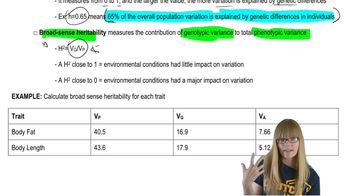For the traits listed in the previous problem, which do you think are likely to be multifactorial traits, with phenotypes that are influenced by genes and environment? Identify two environmental factors that might play a role in phenotypic variation of the traits you identified.
Compare and contrast broad sense heritability and narrow sense heritability, giving an example of each measurement and identifying how the measurement is used.
 Verified step by step guidance
Verified step by step guidance
Verified video answer for a similar problem:
Key Concepts
Broad Sense Heritability

Narrow Sense Heritability

Applications of Heritability Measurements

Define and distinguish epistasis and pleiotropy.
In a test of his chromosome theory of heredity, Morgan crossed a female Drosophila with red eyes to a male with white eyes. The females were produced from Cross A shown in Figure 3.19. Predict the offspring Morgan would have expected under his hypothesis that the gene for eye color is on the X chromosome in fruit flies.
In a cross of two pure-breeding lines of tomatoes producing different fruit sizes, the variance in grams (g) of fruit weight in the F₁ is 2.25 g and the variance among the F₂ is 5.40 g. Determine the genetic and environmental variance (VG and VE) for the trait and the broad sense heritability of the trait.
Describe the difference between continuous phenotypic variation and discontinuous variation. Explain how polygenic inheritance could be the basis of a trait showing continuous phenotypic variation. Explain how polygenic inheritance can be the basis of a threshold trait.
In Drosophila, the map positions of genes are given in map units numbering from one end of a chromosome to the other. The X chromosome of Drosophila is 66 m.u. long. The X-linked gene for body color—with two alleles, y⁺ for gray body and y for yellow body—resides at one end of the chromosome at map position 0.0. A nearby locus for eye color, with alleles w⁺ for red eye and w for white eye, is located at map position 1.5. A third X-linked gene, controlling bristle form, with f⁺ for normal bristles and f for forked bristles, is located at map position 56.7. At each locus the wild-type allele is dominant over the mutant allele.
In a cross involving these three X-linked genes, do you expect any gene pair(s) to show genetic linkage? Explain your reasoning.
